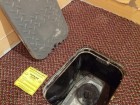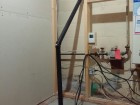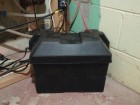Retrofit home highlights actions homeowners can take to reduce the risk of basement flooding
0 December 16, 2014 at 1:56 pm by Glenn McGillivrayOn December 11, the Institute for Catastrophic Loss Reduction (ICLR) rolled out its latest retrofit home to the media. The home in Burlington, Ontario was retrofitted to reduce the risk of basement flooding. ICLR chose Burlington because it was ground zero for a major urban flooding event on August 4, 2014 when the city was inundated with about two months worth of rain in just a few hours. About 3,500 area homeowners reported flood damage to the city as result of the storm.
One such homeowner included Burlington Mayor Rick Goldring, who attended the retrofit unveiling. The Mayor’s basement flooded during the rainstorm and he has since installed many of the measures put into the ICLR home. Also in attendance was Burlington resident Kathy Bardswick, President and CEO of The Co-operators and ICLR board chair. Both provided a few thoughts to attendees.
Burlington, of course, is not alone in experiencing basement flooding, as many cities across Canada have been impacted by significant urban flooding events over the past few years. Indeed, in just the last year and a half alone, severe rainfall lead to significant urban flooding in southern Alberta and Toronto/Mississauga, as well as Burlington, leading to almost $3 billion in insured damage.
When it rains hard, it rains on private property, too
ICLR recognizes that effective management of flood risks not only requires investment and upgrading of municipal sewer infrastructure, but also must include actions taken by educated homeowners to reduce the risk. Protecting private properties from flooding is a shared responsibility, and this retrofit demonstrated a number of ways that property owners can help guard against basement flooding.
Several basement flood mitigation measures were put into the Burlington home, which is located in an area of the city that was particularly hard-hit during the August 4 event. These measures include:
- Disconnection of the foundation drain from the sanitary sewer connection
- Installation of a sump, sump pump, and battery backup system
- Installation of a backwater valve on the sanitary sewer connection
- Alteration of lot-grading, including installation of a swale to better facilitate surface drainage
- Installation of window wells and window well covers to facilitate the change in lot grading
- Cleaning of the foundation drain system
At the time of the retrofit, the homeowner had already disconnected his home’s downspouts from the weeping tiles.
ICLR is a centre of excellence in the area of basement flood risk reduction and has produced a large amount of information to educate homeowners, insurers and others about risk reduction.
Among its many resources, ICLR has produced a ‘Handbook for Reducing Basement Flooding’, a publication that addresses the concerns of homeowners, local governments and insurance companies of the increasing instances of basement flooding. The booklet provides comprehensive information on how to mitigate flood risk for individuals and communities. It contains 20 measures that homeowners can take to reduce their risks and their neighbourhoods’ risk of basement flooding. ICLR has also produced a smaller, more readable version of the handbook that is more manageable for the average homeowner.
The Institute has also produced a series of six ‘how to’ videos and six narrated animations on reducing the risk of basement flooding.
ICLR has also just released a new book outlining how Canadian communities large and small are taking action to reduce the risk of basement flooding and damage to property from sewer back-up. ‘Cities adapt to extreme rainfall: Celebrating local leadership’ describes 20 of the many successful local projects currently under way or already completed in communities working to address the risks associated with extreme rainfall.
ICLR has retrofitted a total of 13 homes through its Showcase Homes program:
London – tornado (2003)
Halifax – hurricane (2004)
Vancouver – earthquake (2005)
Ottawa – winter storm (2006)
Edmonton – tornado (2007)
Montreal – ice storm (2008)
Toronto – winter storm/blackout (2009)
– North York – basement flooding (Aug. 19, 2009)
Jasper – wildfire (2010)
Hamilton – basement flooding (2011)
Moncton – basement flooding (2012)
Quebec – earthquake and winter storm (2013)
Burlington – basement flooding (2014)
The Institute has also retrofitted a community drop-in centre in Victoria, B.C. for earthquake as well as a number of day care centres for a range of perils.
Note: By submitting your comments you acknowledge that insBlogs has the right to reproduce, broadcast and publicize those comments or any part thereof in any manner whatsoever. Please note that due to the volume of e-mails we receive, not all comments will be published and those that are published will not be edited. However, all will be carefully read, considered and appreciated.









Leave a Reply